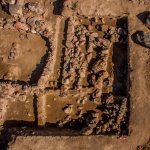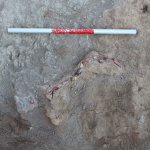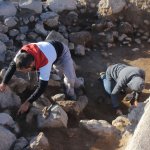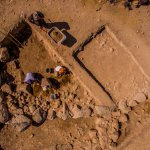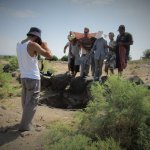The fourth season at Metsamor was the longest in the history of the project. The fieldwork was conducted from 15th of August to 30th of September. The main aim of the season was to extend the excavated area to uncover the broader urban layout of the settlement towards the south, west and east. Moreover, after a five-year gap archaeologist resumed the excavation works in the cemetery area. In the settlement, the team was divided again into three separate groups. Team A worked in the NW part of the excavation area (squares R15, R16, S15 and S16), near structure S4. Team B extended the excavation area towards the south, where a previously conducted survey identified the remains of large building still visible on the surface. Team C returned to the area nearby structure S1, which was explored in 2013 and 2014. The fourth team worked separately inside the chamber of a kurgan which was partially cleaned in the previous excavation.
During their work, team A uncovered the northern part of structure S4 and the remains of a later building, named S6, that is situated westwards. Since it is partially covering structure S4 the team was not able, as of now, to fully understand its function. The most notable discovery in the area was a child burial that was damaged by later activity. The grave can be chronologically connected to the the skeleton found nearby in 2014.
Most of the effort of team B was concentrated on unearthing structure S5 and understanding its internal layout. During their work, team B reached the foundation level of the structure, and came to the conclusion that the building is predated by structure S2 that is located nearby. Thanks to the discovered objects building S5 can be dated to the Achaemenid period.
Team C focused their work in the untouched area eastwards from structure S1, which was destroyed by fire. In squares B16 and B17, the team uncovered the continuation of the destruction layers discovered during the previous seasons, as well as numerous of small finds. Among them was an almost complete necklace formed by golden and sardonyx beads. Furthermore, near the edge of the trench, team C discovered two rooms (S8 and S9) which are dated to the same period as structure S1.
During the exploration of kurgan no. XVIII, the „cemetery team” unearthed a multi -layered burial chamber which was unfortunately robbed already in antiquity. Nonetheless, among the scattered pieces of pottery and human remains the team was still able to discover with meticulous sieving several hundreds of beads made from sardonyx, faience and tin. However, the most exceptional artifacts were 24 golden beads which could originally come from at least two necklaces. Based on these discoveries we can assume that originally the burial chamber was built for a high-ranking person who was buried with many luxurious objects.
Team Members: Krzysztof Jakubiak, Artavazd Zaqyan, Mateusz Iskra, Tigran Zaqyan, Marek Truszkowski, Hasmik Simonyan, Tatiana Adamowska, Menua Gevorgyan, Otto Bagi, Lusine Aleqsanyan, Nerses Mamikonyan, Julia Maczuga, Sergi Manas Jolis, Ann Maele Desmarquoy, Aleksandra Grzegorska, Kornelia Kasperkiewicz, Dominika Majchrzak, Aleksandra Zaleska, Zofia Arcab, Anna Wezranowska, Maciej Sobczak, Elisabeth Bastien, Karol Zajdowski, Joanna Dzik
Back to publications


